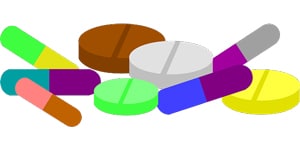
November 11, 2019
Don’t Lose Those Meds
By Michael D. Shaw
Big Pharma certainly has an image problem. In fact, according to a Gallup Poll released in September, 2019, it is currently the most hated industry in the US. The covering webpage notes that: “The new low in the pharmaceutical industry’s U.S. image comes amid a range of criticisms of industry norms, from generating the highest drug costs in the world to spending massive amounts in lobbying politicians to the industry’s role in the U.S. opioid crisis.”
However, people often lose sight of the fact that many medicines which are common—and inexpensive—these days did not exist in past decades. Indeed, former president Franklin Roosevelt suffered from hypertension, but the applicable drugs we now take for granted did not exist then. It is quite likely that this untreated hypertension led to his fatal stroke at the age of 63.
Although the stroke was publicly referred to as a “bolt out of the blue,” anyone who saw him in person during his final years knew he looked terrible. Yet, it was not until 1970 that certain details did emerge.
At that time, Roosevelt’s cardiologist, Dr. Howard G. Bruenn, disclosed in a medical journal article that for many years the president’s blood pressure was dangerously high. Available records show that it had risen to 230/126 in 1944, from 128/82 in 1930, which would have contributed to heart failure. A reading moments before he died was 300/190. It is highly probable that his condition could have been brought under control with today’s pharmaceuticals.
Likewise, back in the 1950s, it was easy enough to diagnose diabetes, but the sole therapeutic option for type 2s was insulin. And remember, such injections were commonplace long before the availability of accurate and inexpensive blood testing strips, read on a meter. Thus, an effective but brute force therapy was all that we had, with no simple feedback testing mechanism, and good glycemic control was simply not possible.
Last May, this column presented some interesting statistics on pharmaceutical drug use in the US. Here’s a recap:
According to research published in the Mayo Clinic Proceedings in 2013, 68.1 percent of Americans are on at least one prescription drug, and 51.6 percent take two. 21.2 percent take five or more. It is estimated that in 2019, 4.25 billion retail prescriptions will be filled throughout the United States.
The May column also included ways to keep track of your meds and to remind you of when to take them, as well as being on the alert for side effects. But, compared to the past when a president could do little more than become a walking dead man, most folks will gladly deal with the complications and hassles of being on those meds. One of the biggest hassles would be losing the drugs.
In the simplest case, you would have a package of meds with you, as you left home, and this became misplaced. If you were still within the US, and were dealing with a national chain, you could arrange—with some effort—to have a replacement order waiting for you at a nearby pharmacy. However, if they were lost or stolen in a foreign country, this can become a much greater ordeal.
Fortunately, meds—and other items—can be tracked using cellular technology. I was recently introduced to Found by Pebblebee, the latest offering from a company already well-established in the tracking space. Found is the only 5G LTE-M tracker that activates just while you’re looking for it. Features include:
- Accelerometer for motion tracking
- Works with Alexa and Google Assistant
- Left behind notification
- Last known location
As Daniel Daoura, founder and CEO of Pebblebee, puts it:
“A real-time cellular location tracker appeals to a variety of users, including health-conscious consumers who can’t afford to lose, misplace, or forget to take their medications. Pebblebee Found is a durable, no subscription required, always-on solution for locating medicine, valuables, and other personal items.”
“Water-resistant and synchronous with Alexa and Google Assistant, Found shows and tells users where something is. The loud ringer with volume control sets the tone—and represents a new standard—in helping people find what they need when they need it, anywhere cellular is available, with long range Bluetooth as a backup.”
